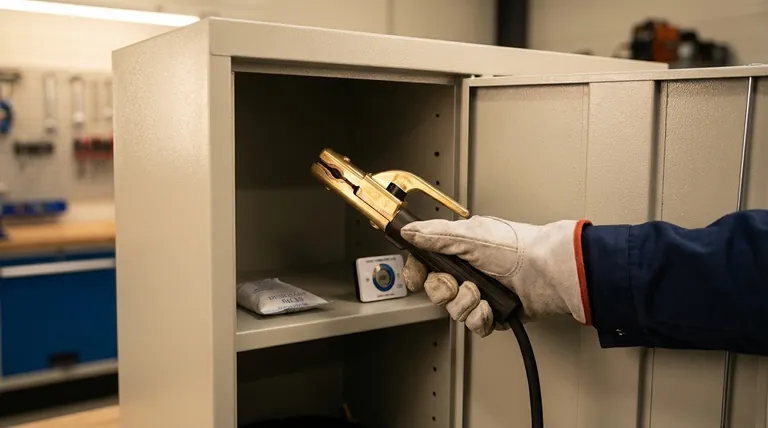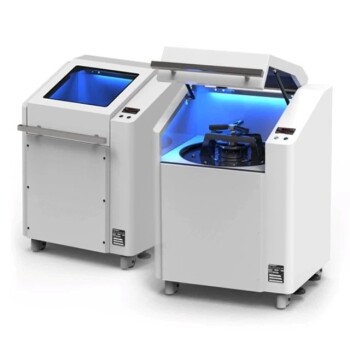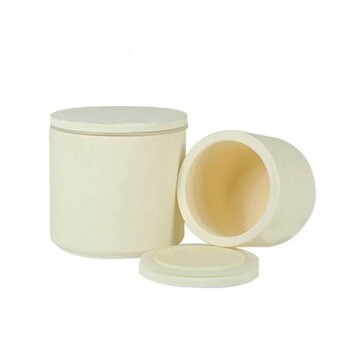Proper storage is crucial for the performance and lifespan of your metal electrode holders. To prevent degradation, they must be stored in a dry, controlled environment, ideally within a moisture-proof cabinet. This single practice is the most effective way to combat the primary threats of rust and oxidation that compromise their function.
The goal of proper storage is not simply to keep electrode holders out of the way. It is to actively preserve their two core functions: maintaining a secure mechanical grip on the electrode and ensuring flawless electrical conductivity for a stable arc.

The Primary Threat: Moisture and Oxidation
An electrode holder is a simple tool, but its performance depends on keeping metal components clean and conductive. The biggest enemy to this is environmental exposure, specifically to moisture.
Compromising Electrical Conductivity
The jaw and contact points of an electrode holder are designed for maximum current transfer. When these metal surfaces oxidize or rust, a layer of insulation forms.
This insulating layer impedes the flow of electricity. The result is a poor connection, which can lead to arc instability, sputtering, and difficulty striking the arc. The resistance also generates excess heat in the holder itself rather than at the weld, reducing efficiency and creating a safety hazard.
Degrading Mechanical Integrity
Moisture doesn't just affect conductivity; it attacks the mechanical components. The spring mechanism that provides clamping force can rust and seize, making it difficult to insert or remove electrodes.
Furthermore, corrosion on the jaw surfaces can weaken their grip, causing the welding electrode to slip or sit at an improper angle during use.
The Impact on Safety
A compromised electrode holder is a dangerous one. A poor electrical connection can cause the holder to overheat significantly, posing a severe burn risk to the welder. A weak grip can cause a live electrode to fall, creating a fire or electrical shock hazard.
Common Pitfalls and Poor Practices
Simply putting the holder away is not enough. Avoiding common mistakes is just as important as following best practices.
Leaving the Holder on the Shop Floor
Concrete floors are notorious for wicking moisture from the ground, creating a humid micro-environment. Leaving a holder on the floor, even overnight, directly exposes it to this corrosive moisture. It also puts the tool at risk of being stepped on or run over.
Tossing It in a General Tool Bucket
Throwing an electrode holder into a shared bucket with grinders, hammers, and other heavy tools is a recipe for damage. The jaws can be dented and the insulating handle can be cracked or chipped, compromising both performance and safety.
Storing with an Electrode Clamped In
Leaving an electrode clamped in the holder for long periods can cause the spring to lose some of its tension over time. This leads to a weaker grip and a less secure connection in the future.
Making the Right Choice for Longevity
Proper storage is a simple discipline that pays dividends in performance, safety, and equipment lifespan. Integrate these habits into your post-weld cleanup routine.
- If your primary focus is maximum performance and safety: Always wipe down the holder after use and store it in a designated dry cabinet or toolbox, separate from other heavy tools.
- If you work in a high-humidity environment: Enhance your dry storage by adding a renewable desiccant pack (silica gel) to absorb ambient moisture.
- If you need a quick, short-term solution: At the very least, hang the holder on a dedicated rack or hook, ensuring it is off the floor and away from any direct sources of moisture.
Protecting your tools is a direct investment in the quality and safety of your work.
Summary Table:
| Storage Practice | Impact on Longevity | Key Benefit |
|---|---|---|
| Dry, Moisture-Proof Cabinet | Prevents rust and oxidation | Preserves electrical conductivity and mechanical grip |
| Off the Floor, on a Hook/Rack | Avoids moisture from concrete | Reduces risk of corrosion and physical damage |
| Separate from Heavy Tools | Prevents dents and handle damage | Maintains structural integrity and safety |
| Electrode Removed After Use | Prevents spring fatigue | Ensures a secure grip over time |
Maximize the lifespan and safety of your welding equipment. Proper storage is just one part of a well-maintained lab or workshop. KINTEK specializes in high-quality lab equipment and consumables, providing reliable solutions for all your professional needs. Contact us today to discover how our products can enhance your efficiency and safeguard your investments.
Visual Guide

Related Products
- Custom PTFE Wafer Holders for Lab and Semiconductor Processing
- Stainless Steel Quick Release Vacuum Chain Three-Section Clamp
- Quartz Electrolytic Electrochemical Cell for Electrochemical Experiments
- Electrolytic Electrochemical Cell for Coating Evaluation
- Double-Layer Water Bath Electrolytic Electrochemical Cell
People Also Ask
- What inspections should be performed on the PTFE electrode stand before use? Ensure Safe & Accurate Electrochemical Measurements
- What is the correct way to place items into a PTFE cleaning basket? Master the Art of Perfect, Repeatable Cleaning
- What is chemical vapor deposition substrate material? The Foundation for High-Quality Thin Films
- How should the PTFE electrode stand and its components be cleaned after use? A Step-by-Step Guide to Prevent Contamination
- What are the temperature and pressure limitations for using the sample holder? Essential Guide for Lab Safety



















